
65+ recruitment stats HR pros must know in 2018

2018 is here and it’s time to look at the current developer hiring landscape. The tech recruitment industry is constantly changing and to help HR professionals keep up, each year industry leaders release reports packed full of HR statistics. These can serve as a benchmark and hopefully turn make tech hiring data-driven discipline across companies worldwide.
To help you make informed hiring decisions in 2018, we’ve gone through volumes of research from a number of organizations including Stack Overflow, Google, Manpower Group, Society for Human Resource Management, Glassdoor, Deloitte University Press, Edelman Trust Barometer, The MRINetwork, Jobvite, PayScale, NFIB, Work Institute, and The American Journal of Health Promotion.
Here are the top 2018 HR statistics to guide you through 2018.
HR statistics and trends
1. Organization of the future (88%), careers and learning (83%), and talent acquisition (81%) are the top three most important 2017 HR trends (81%).
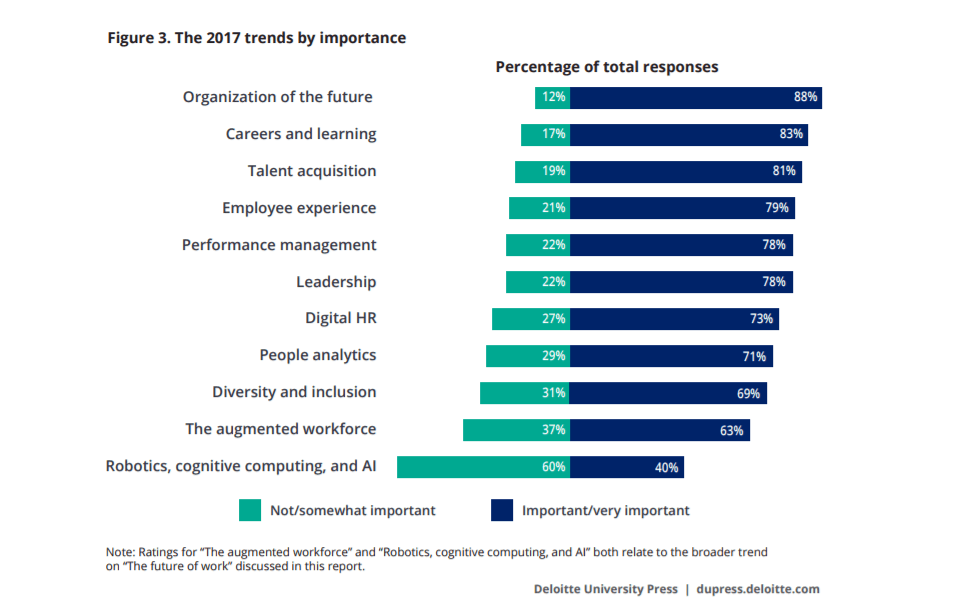 Source: Deloitte University Press
Source: Deloitte University Press
2. 73% of respondents rated Digital HR as an important/very important trend.
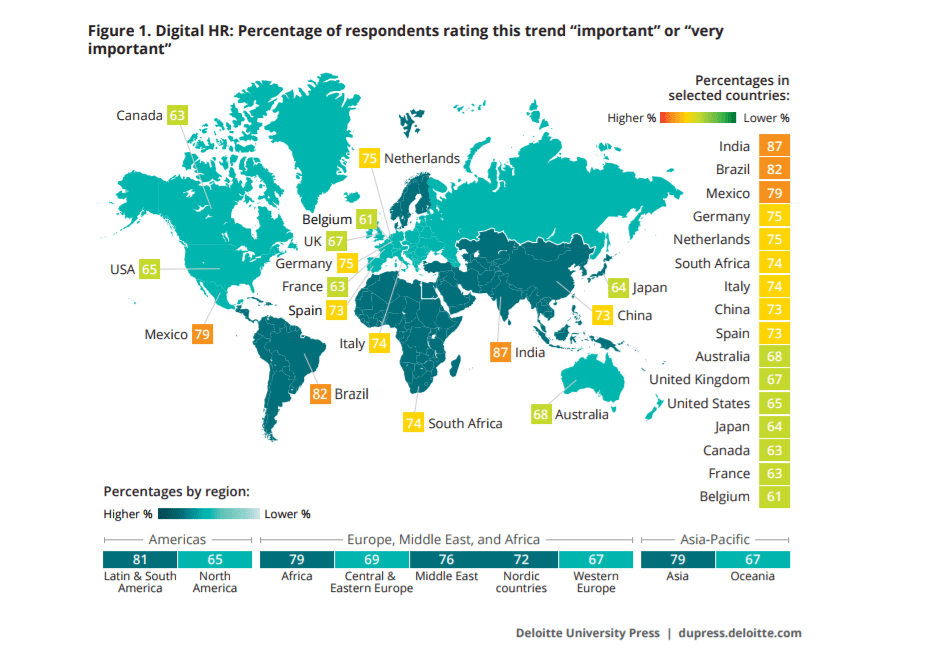 Source: Deloitte University Press
Source: Deloitte University Press
3. 56% of businesses are in the process of “redesigning their HR programs to leverage digital and mobile tools.” (Source: Deloitte University Press)
4.
90% of recruiters say today’s labor market is candidate-driven, up from 86% last year
Click to tweet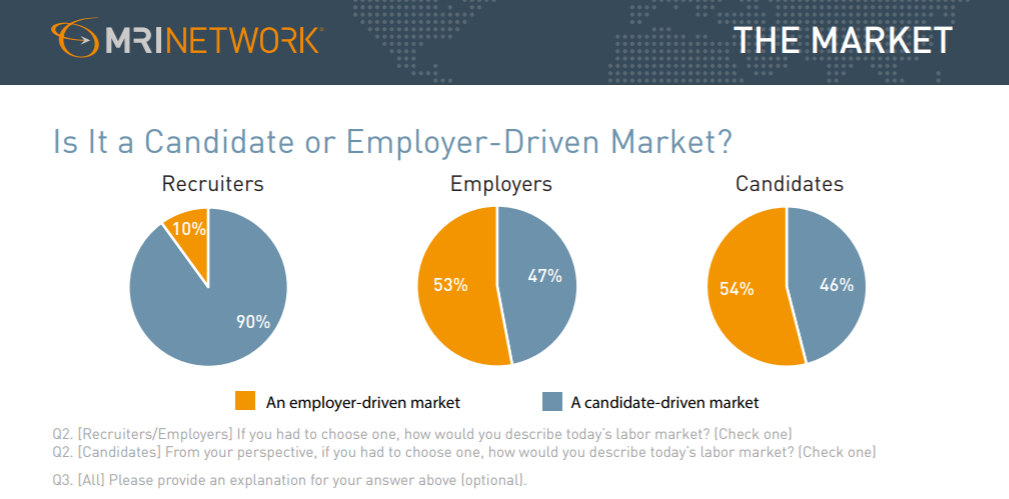 Source: MRINetwork
Source: MRINetwork
5. 47% of employers and 46% of candidates feel that today’s labor market is candidate-driven. Last year, 62% of employers felt the labor market was candidate driven. (Source: MRINetwork)
6. 80% of executives thought employee experience was very important (42%) or important (38%) but only 22% believed they “were excellent at building a differentiated employee experience”.
 Source: Deloitte University Press
Source: Deloitte University Press
7. 72% of recruiters believe advancement opportunities are the most attractive factors to prospective hires. Interestingly, the surveyed “employers and candidates selected competitive compensation packages most often, followed by advancement opportunities, suggesting that compensation is the deciding factor when considering a new job.”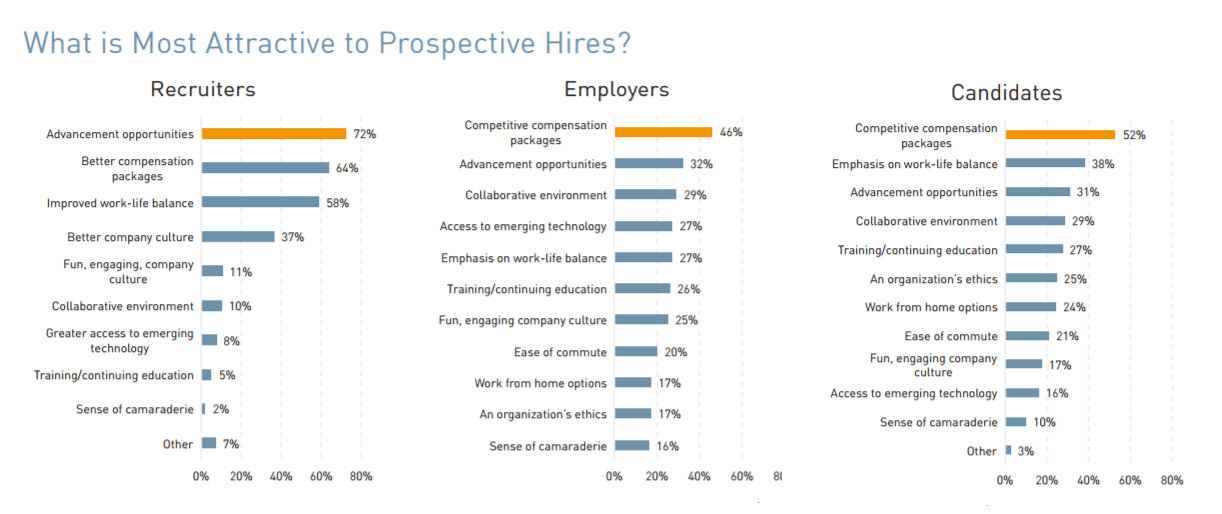
Source: MRINetwork
8. “Employment of software developers is projected to grow 24 percent from 2016 to 2026, much faster than the average for all occupations.“
 Source: The Bureau of Labor Statistics
Source: The Bureau of Labor Statistics
9. 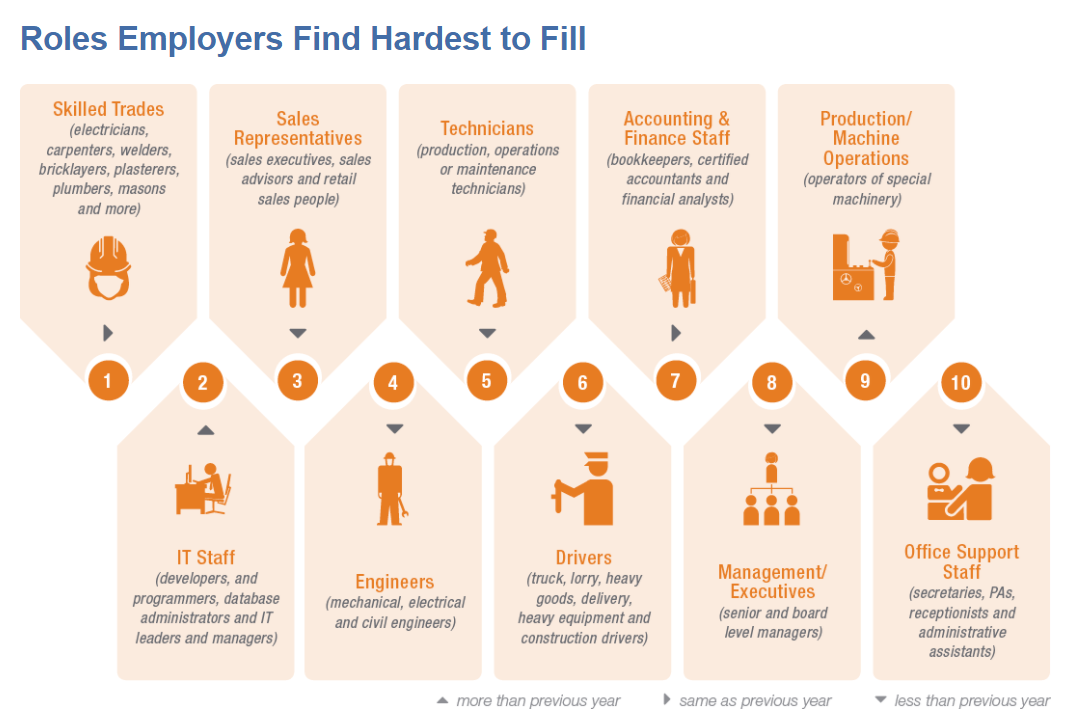
Source: Manpower Group
The challenges of modern recruitment
10. “The proportion of respondents rating their HR capabilities as “Getting by” and “Adequate” has marginally increased, and that rating their capabilities as “Good” has marginally decreased, since 2016.”
 Source: Deloitte University Press
Source: Deloitte University Press
11. Being unable to find suitable candidates (63%) and the candidates not responding to calls or emails (47%) are the primary barriers to hiring according to recruiters. For 80% employers, receiving “too many unqualified, junk resumes from job boards” is the number one obstacle to hiring, followed with “difficulty finding passive talent” in the second place (65%).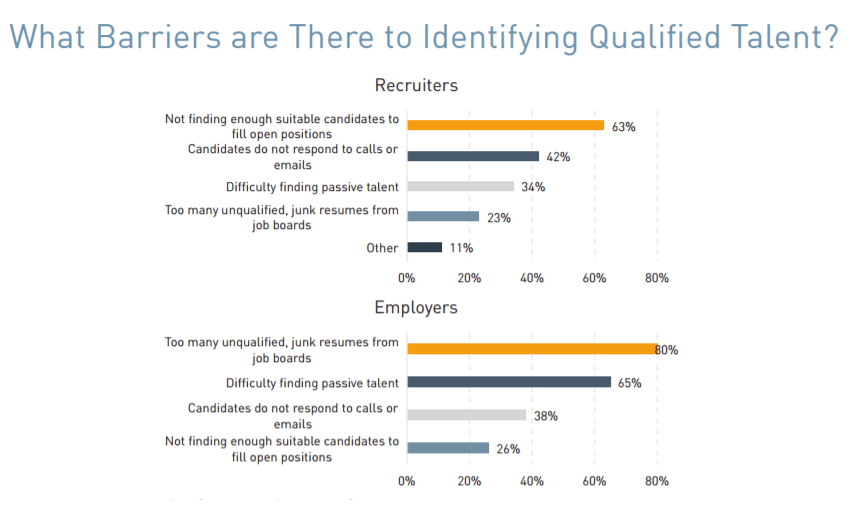
Source: MRINetwork
12. 59% of small businesses report hiring or attempting to hire. However, 54% of them report they found few or no candidates for the positions, setting a record high. (Source: NFIB)
13. 19% of small business owners “cited the difficulty of finding qualified workers as their Single Most Important Business Problem (…), second only to taxes”. (Source: NFIB)
14. In December 2017, 54% of small business owners reported few or no qualified applicants for the open positions they were offering. When considering those trying to hire only, this number rises to a staggering 92%.
Source: NFIB
15. In December 2017, 31% of small business owners said that in the current period they offered positions they were unable to fill. Based on 2012-2017 NFIB data, 2017 brought record highs (30%-35%).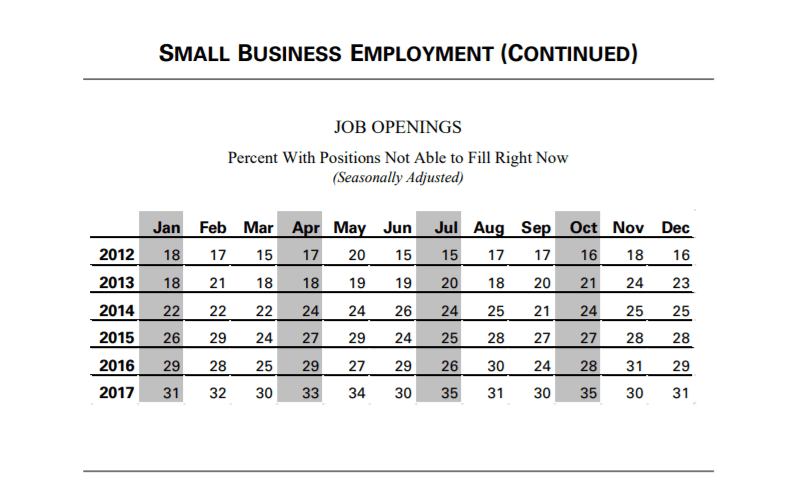
Source: NFIB
Job search & the interview process
16.
. Source: Stack Overflow
Source: Stack Overflow
[sociallocker id=”115880″]
17. Referrals from friends, family, and former colleagues are the top source of job discovery for software developers (26.8%).
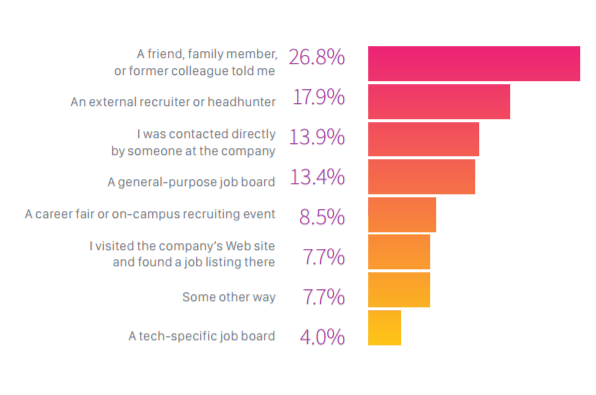 Source: Stack Overflow
Source: Stack Overflow
18. 76.7% of developers are employed full-time.
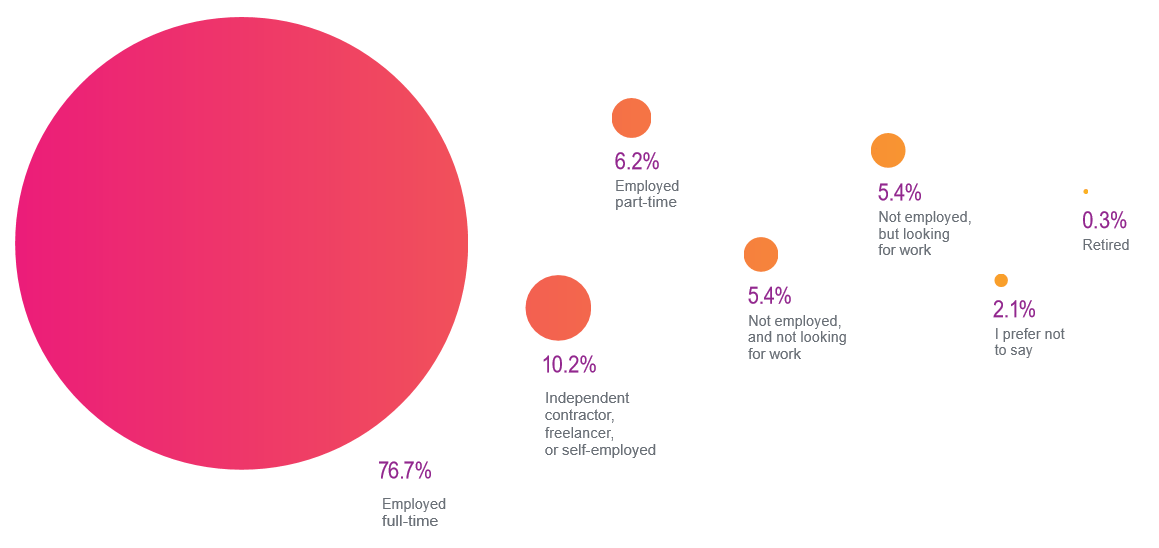 Source: Stack Overflow
Source: Stack Overflow
19.
.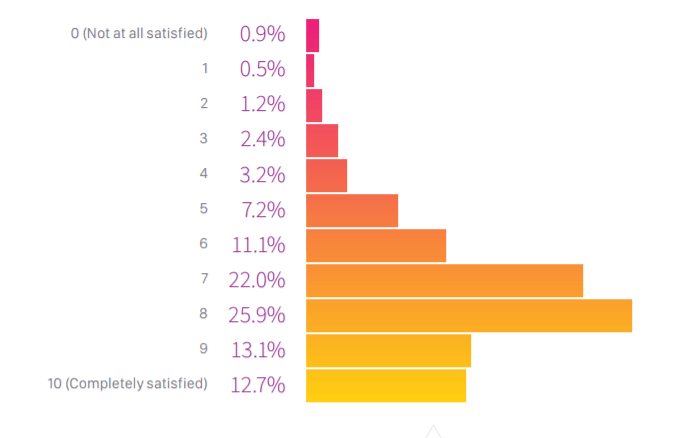 Source: Stack Overflow
Source: Stack Overflow
20. “Glassdoor users report that they use an average of 7.6 job sites during their job search (median is 4).” (Source: Glassdoor)
21.
(Source: Glassdoor)22. The interview process takes 24.4 days for Internet & Tech jobs and 23.9 days for Computer Software and Hardware positions.
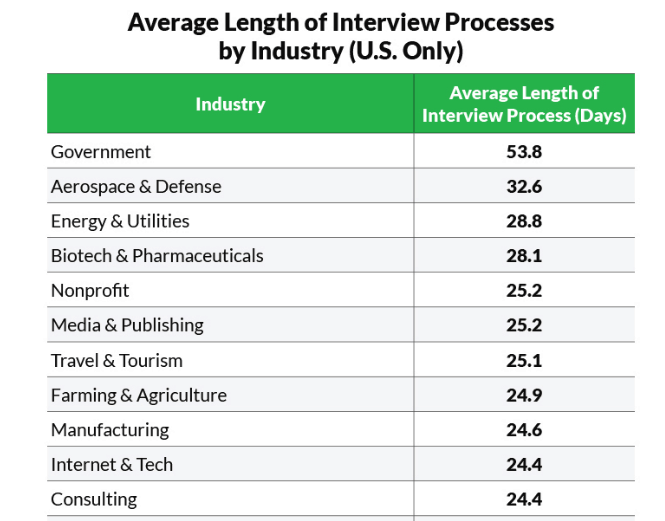 Source: Glassdoor
Source: Glassdoor
23. Software Development Engineer ranks sixth on Glassdoor’s list of 25 jobs with the longest interview processes in the United States with 40.8 days on average.
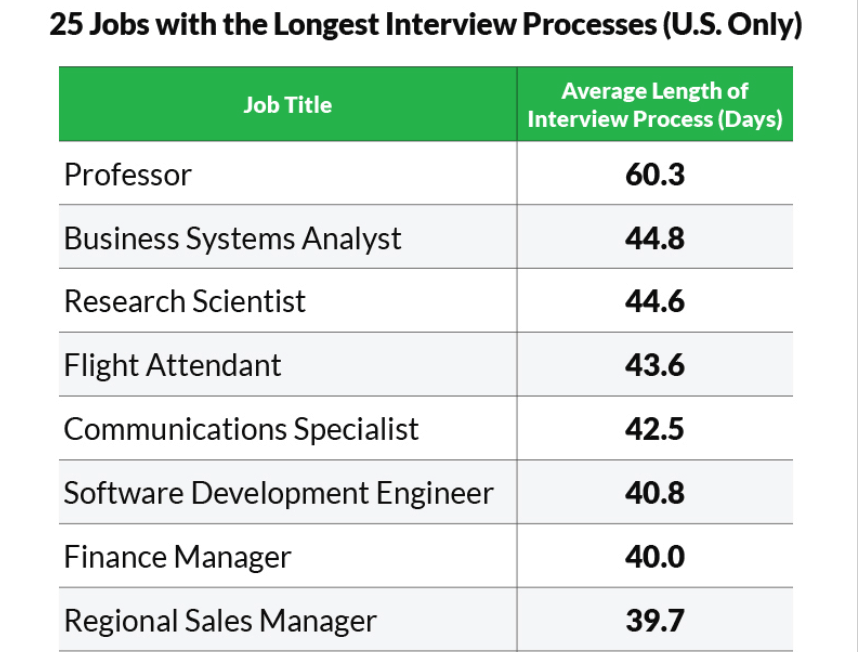 Source: Glassdoor
Source: Glassdoor
24. 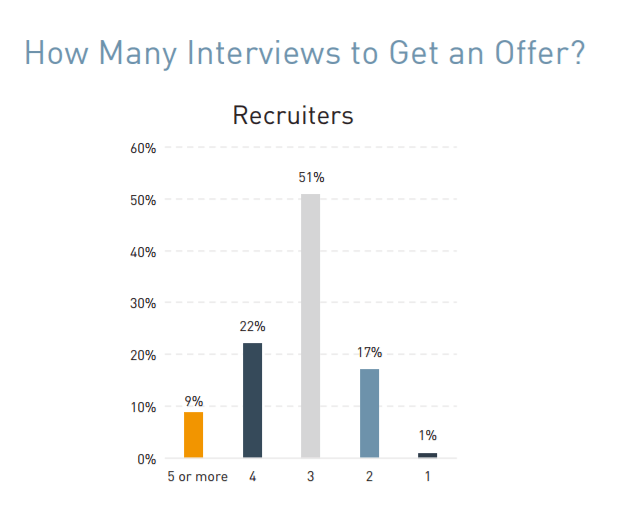
Source: MRINetwork
25. A total of four interviews is enough to make a reliable hiring decision.
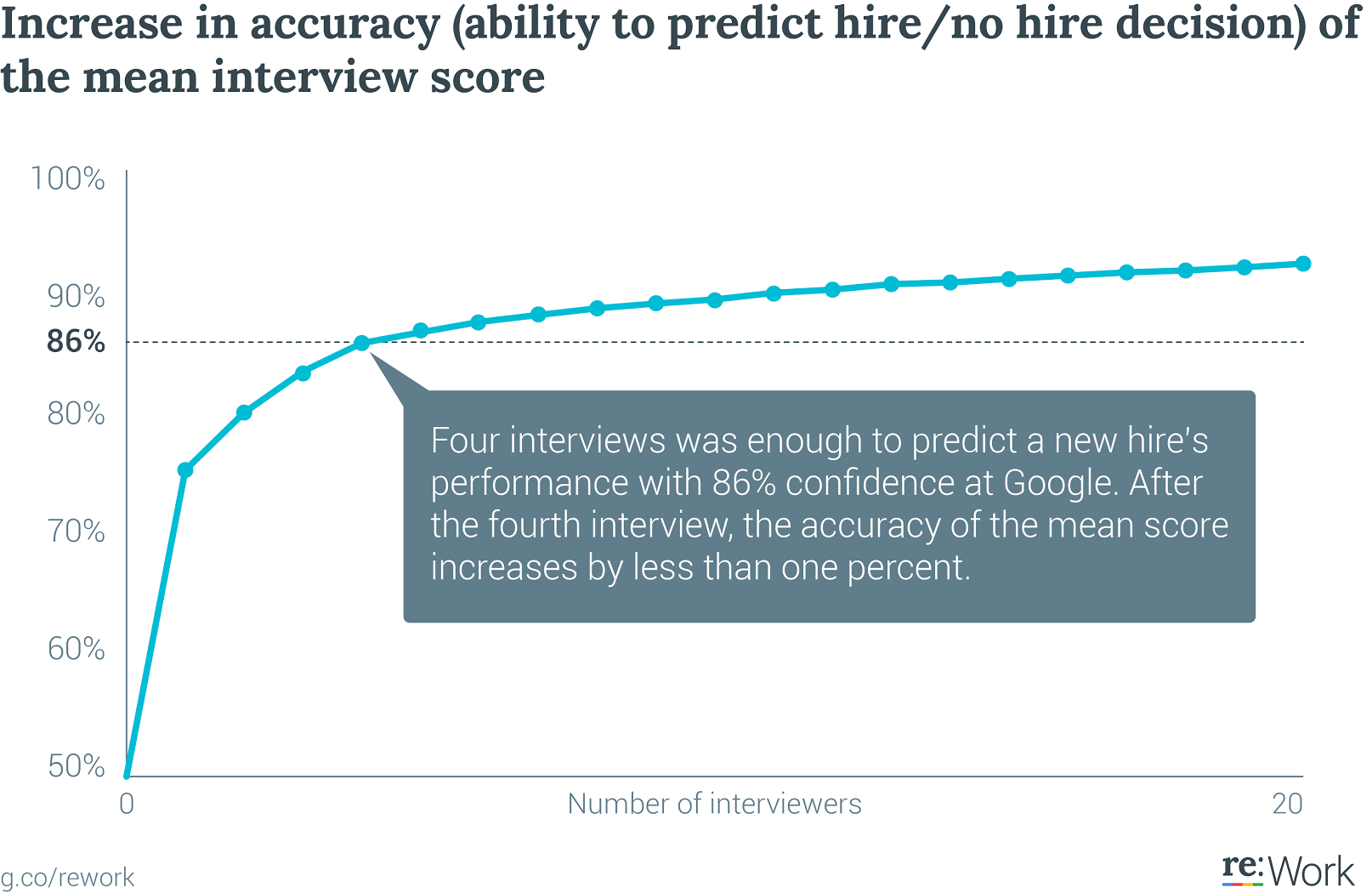 Source: re:Work
Source: re:Work
26. .
Source: Glassdoor
Salary & negotiating pay
27. The average salary for a Software Developer in the United States is $79,604/yr (range: $59k-$115K).
Source: Glassdoor
28. Median Software developer salary is $69,300 per year.
 Source: PayScale
Source: PayScale
29. 44.8% of developers feel somewhat underpaid and a further 10% feel greatly underpaid.
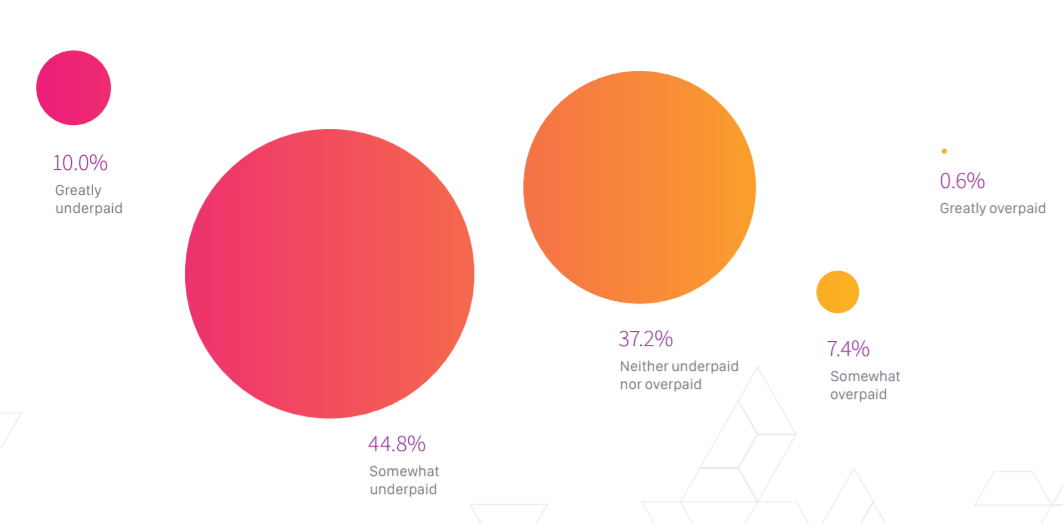 Source: Stack Overflow
Source: Stack Overflow
30. 84% of individuals looking for a job report that salary negotiations resulted in higher pay (84%). (Source: Jobvite)
31.
. (Source: Jobvite)32. 17% of recruiters decided not to offer the job to the candidate due to them negotiating pay. (Source: Jobvite)
33. 51% of recruiters admit negotiating pay negatively impacted the decision to extend a job offer. (Source: Jobvite)
Recruitment costs
34. $4,129 is the average Cost-per-Hire. (Source: SHRM)
35. It costs $31,940 and takes 6 weeks to recruit a dev. (Source: DevSkiller)
36. The cost of recruiting a bad programmer is $485,371.38 assuming a bad hire’s 8-week tenure. (Source: DevSkiller)
Average employee tenure & making a job move
37. The average employee tenure is 8 years (no change in comparison to the previous year). (Source: SHRM)
38.
. Source: Glassdoor
Source: Glassdoor
39. 32.3% of developers changed jobs less than 12 months ago and 20.8% accepted a new position between 1 and 2 years ago.
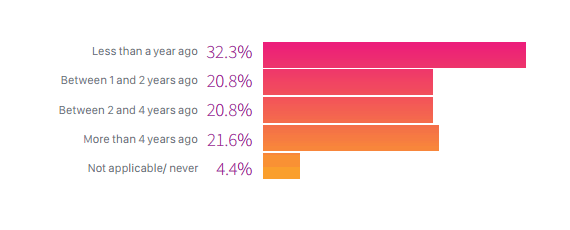 Source: Stack Overflow
Source: Stack Overflow
40. “Combining industry estimates with census data, Work Institute uses an estimate of 33% of a worker’s annual salary to calculate the cost of turnover. When applied to the median U.S. worker’s salary of $45,000, we arrive at an average cost of turnover per employee of $15,000.” (Source: Work Institute)
41.
.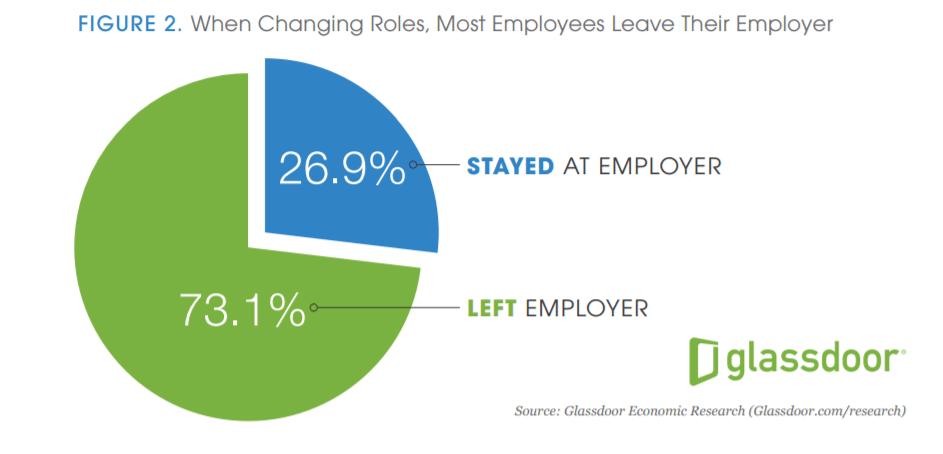 Source: Glassdoor
Source: Glassdoor
42. On average, employees earn a 5.2% pay rise when changing jobs.
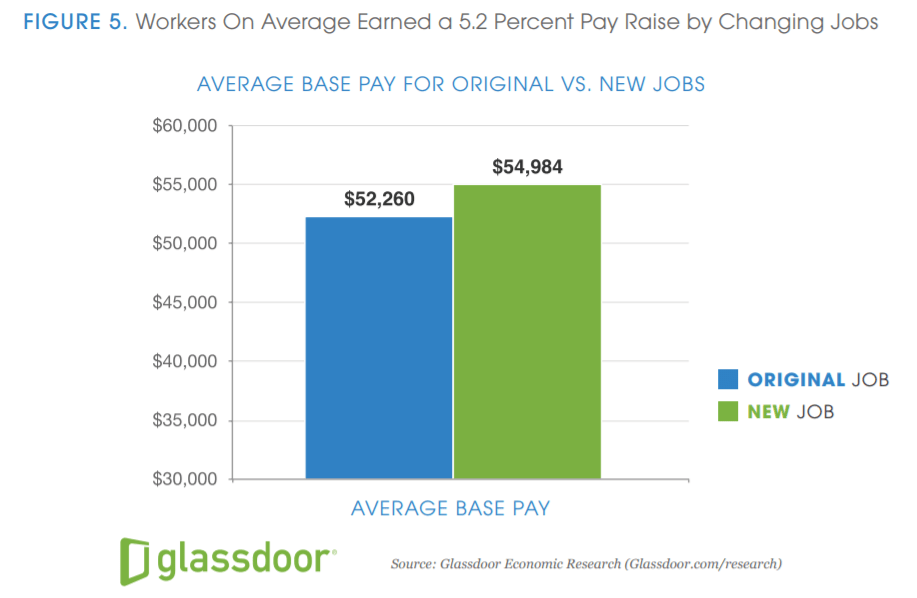 Source: Glassdoor
Source: Glassdoor
43. “The target bonus percentage fell almost 20% compared with last year for both executives and non-executives.” 2017 average annual salary increase is 2.8%, up from 2.7% in 2016. The average target bonus percentage for 2017 reached 8.3% (down from 10.2% in 2016) and 3.8% (down from 4.7% in 2016) for executives and for non-executives, respectively. (Source: SHRM)
44. “Of all the internal mobility within an organization (promotions and transfers), 70% of the movement was due to promotions.” (Source: SHRM)
45. According to recruiters, top three causes of new job openings are:
– Newly created positions: 77%,
– Vacancies from resignations or terminations: 63%,
– Vacancies from retirement: 31%. (Source: MRINetwork)
Recruiter attitudes towards automation/AI
46. “49% of Tech / IT recruiters feel positively toward automation/AI in their own jobs and 46% toward the overall workforce”.
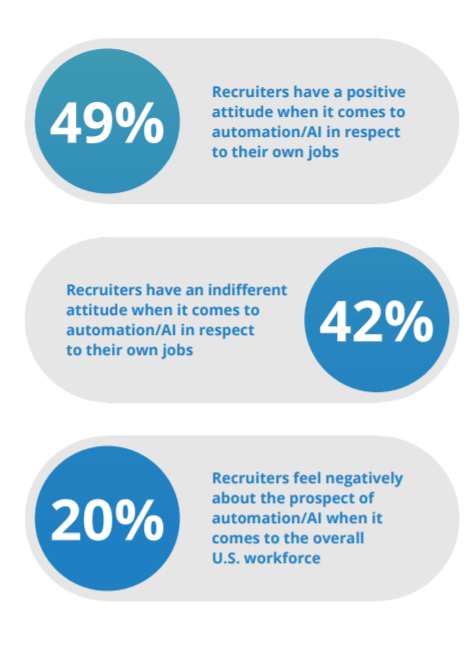 Source: Jobvite
Source: Jobvite
47. 55% of recruiters believe that in the next three years, no one in the company will be let go because of AI/automation. This number drops to 31% and 22% in the case of a 5-10 year period and 10-20 year period, respectively.
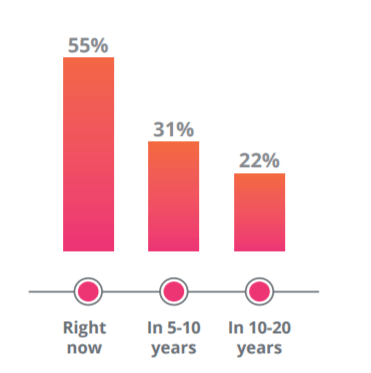 Source: Jobvite
Source: Jobvite
48.
.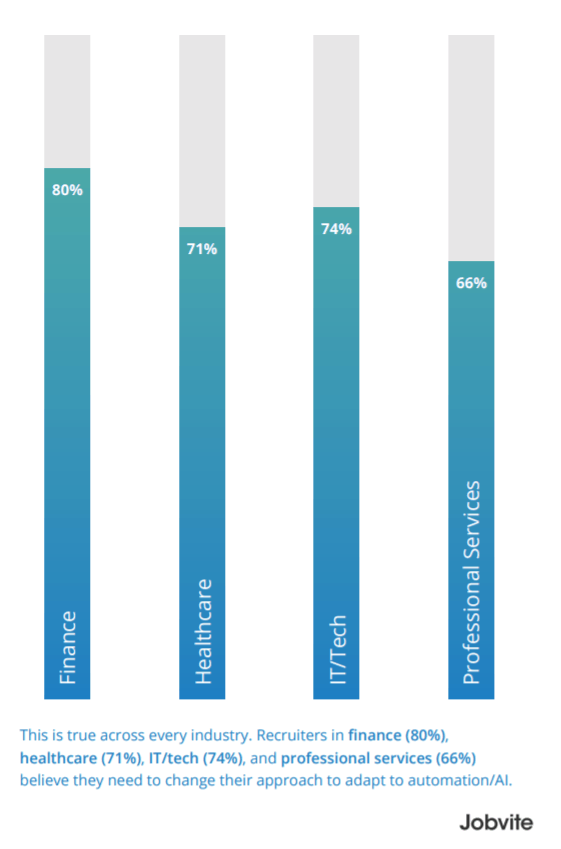
Source: Jobvite
49. 54% of recruiters would like to automate interview scheduling and 52% of them are eager to automate background checking.
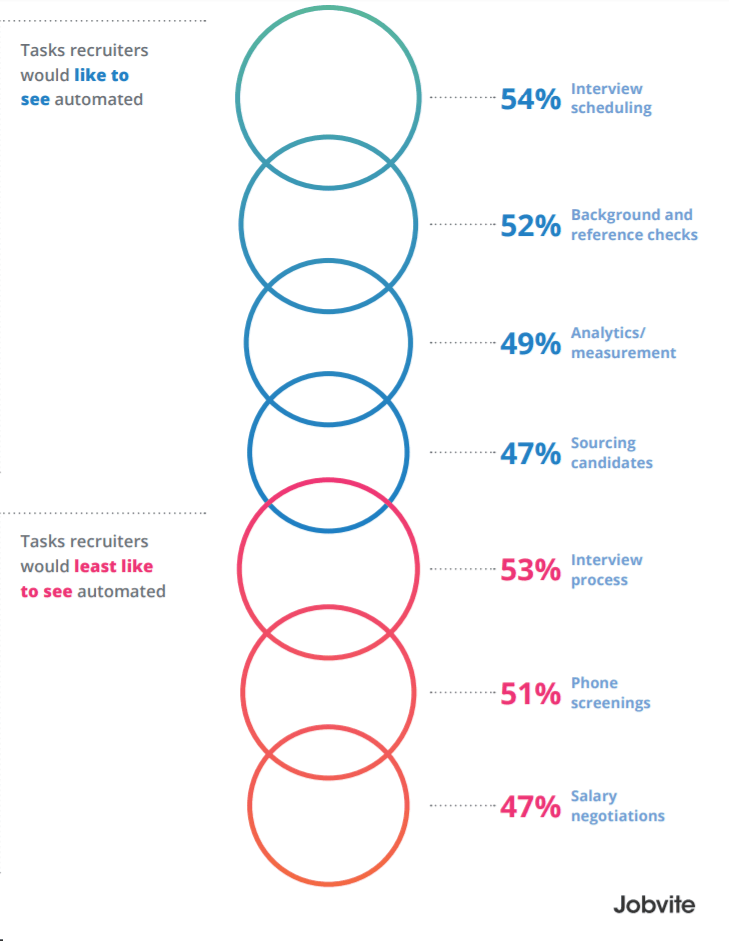 Source: Jobvite
Source: Jobvite
50. The interview process tops the list of tasks recruiters would least like to see automated (54%) and is followed by phone screenings (51%) and salary negotiations (47%). (Source: Jobvite)
51. Recruiters believe some skills cannot be fully replaced by AI. These include leadership/management (79%), offering negotiation (59%), and creative writing (47%).
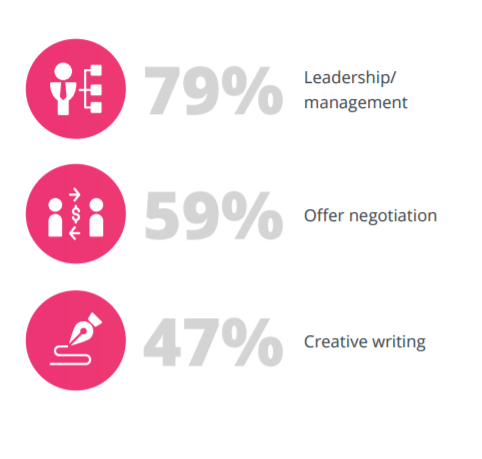 Source: Jobvite
Source: Jobvite
Education
52. Over 50% of recruiters and 44% of employers have no preference regarding the type of degree the candidate earned (traditional vs. online). However, a further 48% of recruiters and 43% of employers favor traditional degrees.
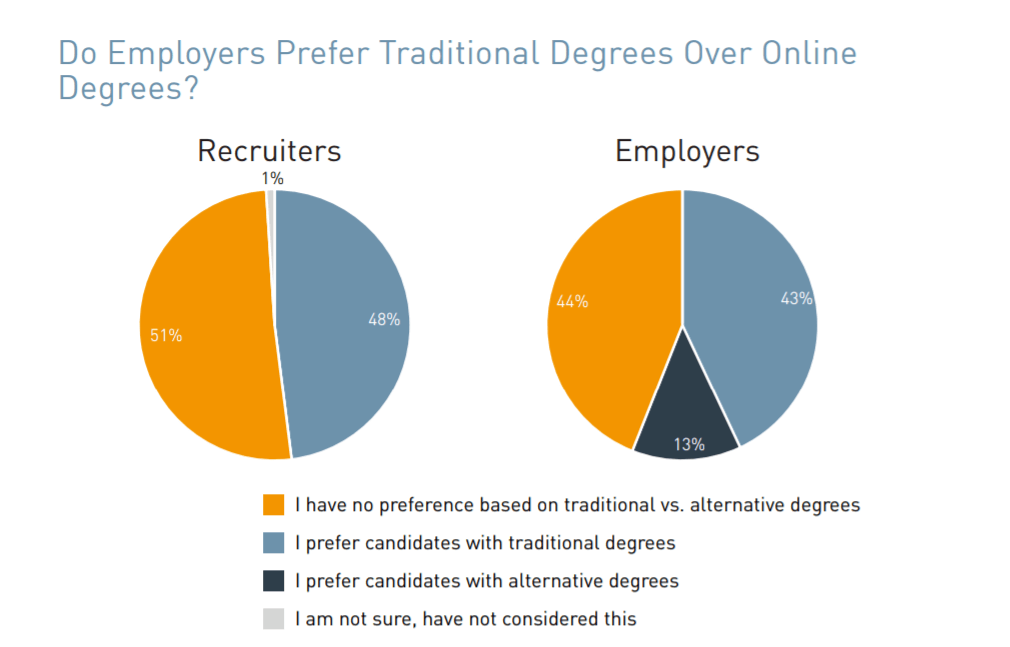 Source: MRINetwork
Source: MRINetwork
53. Over 90% of developers report they are at least partially self-taught.
Source: Stack Overflow
Well-being
54. 73% of developers code as a hobby and 32.7% contribute to Open Source in their free time.
 Source: Stack Overflow
Source: Stack Overflow
55. 85% of employees/job seekers believe their employer should “support them in balancing their life between work and personal commitments”. (Source: Glassdoor)
56. “Every dollar invested in wellness programs returned the original dollar plus $2.38.” (Source: American Journal of Health Promotion via Glassdoor)
Recruiter attitudes
57. Over the last three years, recruiters became more relaxed about candidate selfies on social media. Only 7% of recruiters view selfies negatively right now, down from 25% in 2015. 
Source: Jobvite
58.
. (Source: Jobvite)59. 72% of recruiters think candidates lie about their job experience and 63% believe they lie about previous salaries. (Source: Jobvite)
60. 56% of recruiters say that candidates lie about their technical skills.
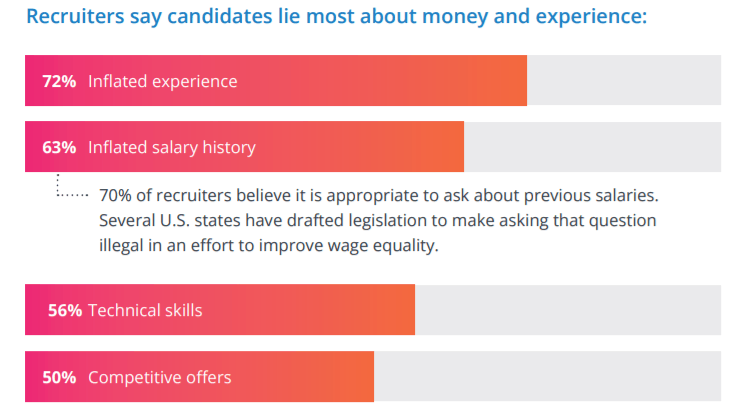 Source: Jobvite
Source: Jobvite
Building trust & fostering engagement
61. 91% of companies believe talent engagement is a priority. (Source: Beamery)
62. “Treating employees well” tops the list of attributes important in building trust in a company. (72% for those who have lost faith in the system and 62% for the general population).
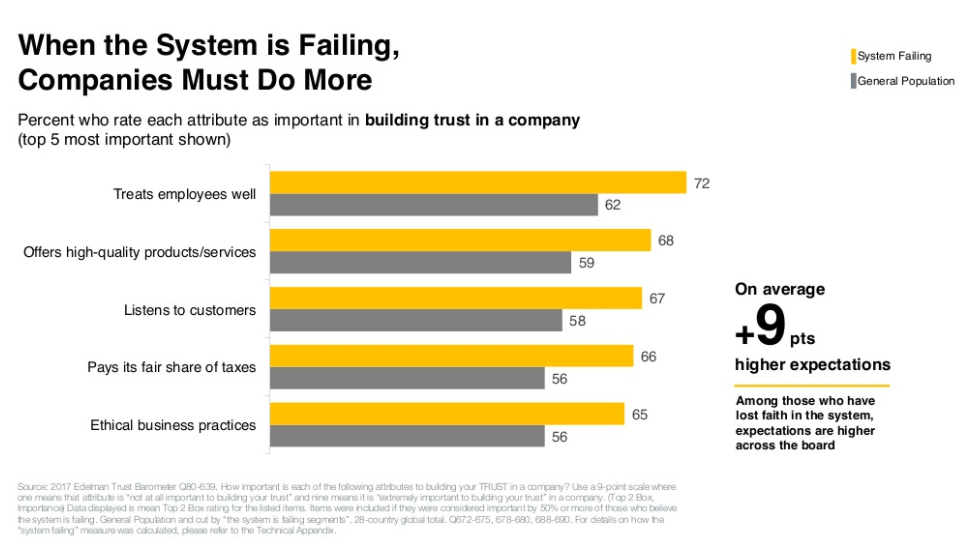 Source: 2017 Edelman Trust Barometer
Source: 2017 Edelman Trust Barometer
63. Employees are seen as the most trusted spokesperson to communicate each topic (30%-53% depending on the subject).
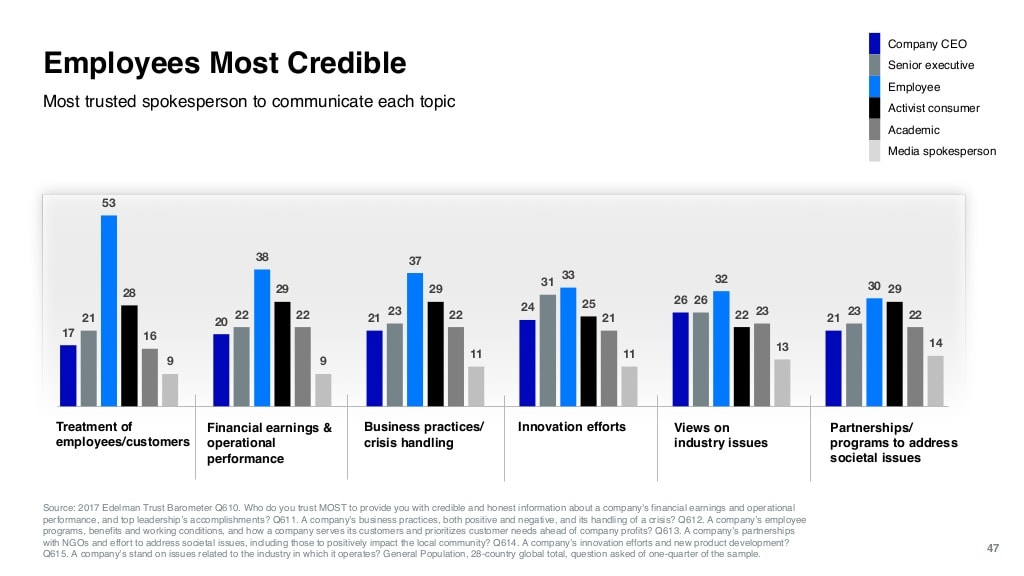 Source: 2017 Edelman Trust Barometer
Source: 2017 Edelman Trust Barometer
64. 57% of recruiters state that “implicit bias is a real problem within the American workforce”. (Source: Jobvite)
65. 61% of recruiters think men get paid more than women do for the same quantity and quality of work. (Source: Jobvite)
66. Despite all the talk of diversity, only 13% of recruiters ranked increasing diversity in their organization as top three priority for the next year. (Source: Jobvite)
67. 69% of executives believe diversity/inclusion is an important issue, up from 59% in 2014.
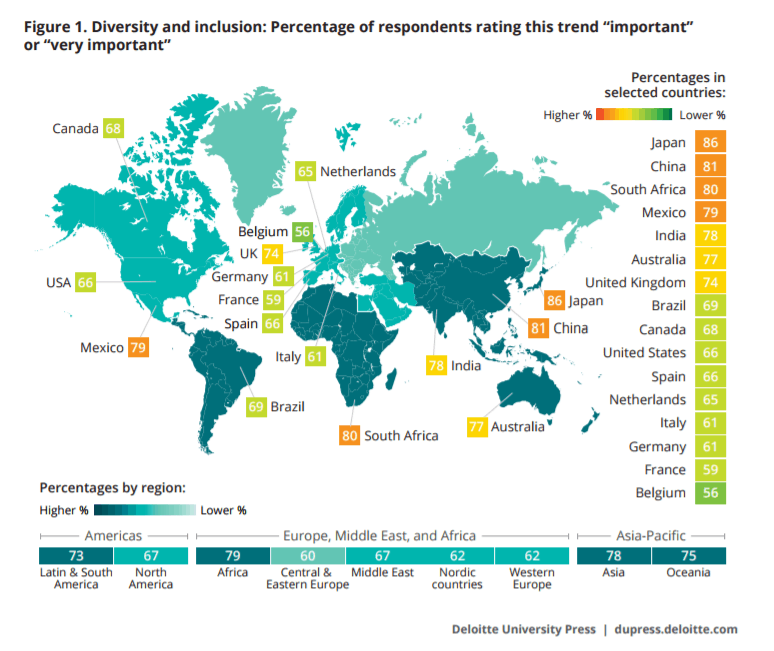 Source: Deloitte University Press
Source: Deloitte University Press
68. Majority of recruiters don’t have specific goals in place when it comes to gender diversity (52%) and ethnic diversity (51%). (Source: Jobvite)
Conclusion
These HR statistics clearly demonstrate that although organizations worldwide perceive certain trends as important, in many cases they aren’t ready to take action. A disappointing 39% of organizations rate their HR capabilities as “good” or “excellent”, so there’s definitely work to be done this year.
Companies struggle to fill open positions and the inability to find qualified candidates remains a problem in 2018. This suggests the war for tech talent won’t cease in years to come. If you want to identify, attract, and retain top tech talent this year, use these statistics to steer you in the right direction.
Happy hiring!
Read also:
14 technical recruitment best practices for 2018
[/sociallocker]




